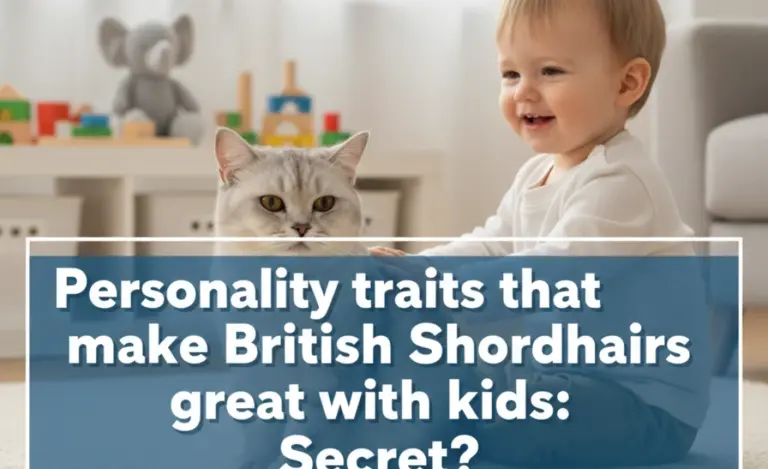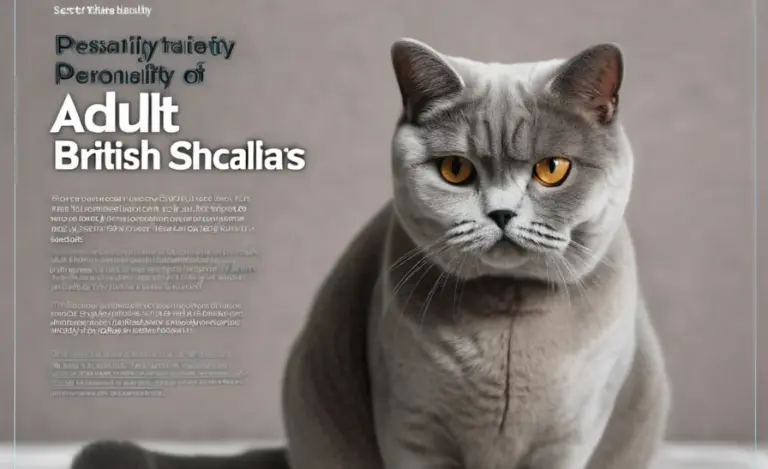How British Shorthairs Behave During Play Sessions: Secret?
British Shorthairs are known for their calm and gentle nature, but they still enjoy playtime! During play, expect to see bursts of energy, playful stalking, and chasing toys. They may exhibit behaviors like pouncing, batting, and even a bit of wrestling. Remember to provide a variety of toys to keep them entertained and engaged.
Bringing a British Shorthair into your home means welcoming a cuddly companion with a dignified air. But don’t let their regal appearance fool you! These cats have a playful side that comes out during their play sessions. Understanding how British Shorthairs behave during play can help you create a stimulating and enjoyable environment for your furry friend. Are you curious about what to expect when your British Shorthair gets playful? This article will walk you through their typical behaviors, preferred toys, and how to make playtime fun and safe.
Understanding British Shorthair Play Behavior
British Shorthairs are not known for being overly energetic or demanding like some other breeds. However, they do enjoy playing, especially when they are kittens and young adults. Their play style is often described as moderate and gentle, but each cat has its own unique personality.
Typical Play Behaviors
Here are some common behaviors you might observe during your British Shorthair’s play sessions:
- Stalking: They may crouch low to the ground and slowly approach their “prey” (a toy).
- Pouncing: A sudden leap onto a toy or object.
- Batting: Using their paws to bat at toys or objects.
- Chasing: Running after toys that are thrown or moved.
- Wrestling: Gently grappling with toys or even your hand (be careful to avoid encouraging biting).
- Kicking: Using their hind legs to kick at a toy they’ve caught.
- Vocalization: Soft meows or chirps may accompany their play.
Why Play is Important
Playtime is crucial for your British Shorthair’s physical and mental well-being. According to the RSPCA, regular play helps to:
- Prevent boredom and destructive behaviors.
- Provide exercise to keep them physically fit.
- Stimulate their minds and satisfy their natural hunting instincts.
- Strengthen the bond between you and your cat.
Choosing the Right Toys
Selecting the right toys can make a big difference in how engaged your British Shorthair is during playtime. Consider the following factors when choosing toys:
Types of Toys
- Interactive Toys: These toys require your participation and help to strengthen the bond with your cat. Examples include:
- Feather wands
- Laser pointers (use with caution, as excessive use can cause frustration)
- Fishing pole toys
- Puzzle Toys: These toys challenge your cat’s mind and encourage problem-solving. Examples include:
- Treat-dispensing balls
- Puzzle feeders
- Stacking cups
- Solo Play Toys: These toys allow your cat to play independently. Examples include:
- Mice and other small plush toys
- Balls
- Scratching posts
Safety Considerations
Safety should be your top priority when choosing toys. Avoid toys that:
- Have small parts that can be easily swallowed.
- Are made of toxic materials.
- Have long strings or ribbons that can cause entanglement.
Regularly inspect toys for damage and replace them as needed. The Cornell Feline Health Center recommends checking toys frequently to ensure they are still safe for your cat.
Examples of Toys
Here’s a table with some examples of toys that are great for British Shorthairs:
| Toy Type | Description | Benefits |
|---|---|---|
| Feather Wand | A wand with feathers attached to the end. | Encourages chasing and pouncing, provides exercise. |
| Treat Puzzle | A puzzle that dispenses treats when solved. | Stimulates the mind, provides mental enrichment. |
| Plush Mouse | A small, soft toy shaped like a mouse. | Satisfies hunting instincts, provides comfort. |
| Laser Pointer | A device that emits a red laser dot. | Encourages chasing and exercise. (Use in moderation and always end the session with a tangible toy to “catch”.) |
Creating a Playful Environment
The environment in which your British Shorthair plays is just as important as the toys you provide. Here are some tips for creating a stimulating and safe play space:
Designated Play Area
Consider creating a specific area in your home dedicated to playtime. This could be a corner of a room or an entire room, depending on the space you have available. The play area should be:
- Safe and free of hazards.
- Equipped with a variety of toys.
- Comfortable and inviting.
Vertical Space
Cats love to climb and explore vertical spaces. Providing cat trees, shelves, and window perches can add another dimension to their play environment. These structures allow your British Shorthair to:
- Satisfy their natural climbing instincts.
- Observe their surroundings from a high vantage point.
- Get exercise and stay active.
Scratching Posts
Scratching is a natural behavior for cats, and providing scratching posts can help protect your furniture from damage. Place scratching posts in areas where your cat likes to scratch, such as near their sleeping area or in their play area. According to TICA (The International Cat Association), scratching also helps cats to:
- Remove the dead outer layer of their claws.
- Mark their territory.
- Stretch their muscles.
How to Engage Your British Shorthair in Play
Even with the right toys and environment, you may need to actively engage your British Shorthair in play. Here are some tips for encouraging your cat to participate:
Timing
Choose a time when your cat is most active and alert. This is often in the morning or evening. Avoid trying to play with your cat when they are tired or uninterested.
Techniques
Use a variety of techniques to engage your cat’s interest. Try:
- Moving the toy in a way that mimics prey (e.g., fluttering a feather wand like a bird).
- Hiding the toy and then revealing it.
- Varying the speed and intensity of the play session.
Patience
British Shorthairs can be independent and may not always be in the mood to play. Be patient and don’t force them to participate. If they seem uninterested, try again later.
Positive Reinforcement
Reward your cat with praise, petting, or a small treat after a successful play session. This will help them associate playtime with positive experiences.
Managing Playtime Aggression
While most British Shorthairs are gentle players, some may exhibit signs of aggression during play. This can include biting, scratching, or hissing. Here’s how to manage it:
Recognizing the Signs
Learn to recognize the signs of overstimulation or aggression in your cat. These may include:
- Dilated pupils.
- A twitching tail.
- Flattened ears.
- Hissing or growling.
Stopping Play
If you notice these signs, stop the play session immediately. Give your cat some space and allow them to calm down.
Redirecting Behavior
If your cat bites or scratches during play, redirect their attention to a toy. This will help them learn that it’s okay to bite and scratch toys, but not people.
Consulting a Professional
If your cat’s aggression is severe or persistent, consult with a veterinarian or a certified cat behaviorist. They can help you identify the underlying cause of the aggression and develop a plan to address it.
Playtime Safety Tips
Ensuring playtime is safe is paramount for your British Shorthair’s well-being. Here are some important safety tips to keep in mind:
- Supervise Playtime: Always supervise your cat during playtime, especially when using interactive toys.
- Avoid Using Hands as Toys: Never use your hands or fingers as toys, as this can encourage biting and scratching.
- Store Toys Properly: When not in use, store toys in a safe place where your cat cannot access them unsupervised.
- Check for Hazards: Before each play session, check the play area for potential hazards such as loose wires, sharp objects, or toxic substances.
Playtime Activities
Here’s a selection of activities you can try with your British Shorthair to keep playtime fun and engaging:
| Activity | Description | Benefits |
|---|---|---|
| Chasing a Laser Pointer | Move the laser dot around the room for your cat to chase. | Provides exercise and stimulates hunting instincts. |
| Playing Fetch | Throw a small toy for your cat to retrieve and bring back to you. | Encourages exercise and bonding. |
| Hunting for Treats | Hide small treats around the room for your cat to find. | Stimulates the mind and provides mental enrichment. |
| Interactive Puzzle Toys | Use puzzle toys that require your cat to solve a problem to get a treat. | Keeps your cat mentally stimulated and prevents boredom. |
British Shorthair Kitten Playtime
Kittens have different needs and behaviors compared to adult cats. Here’s how playtime might differ for British Shorthair kittens:
- Increased Energy Levels: Kittens generally have higher energy levels and require more frequent play sessions.
- Shorter Attention Spans: Their attention spans are shorter, so keep play sessions brief and engaging.
- Learning Through Play: Play is crucial for kittens to develop their motor skills and social behaviors.
- Gentle Play: Be gentle and avoid rough play that could injure a young kitten.
British Shorthair Senior Playtime
As British Shorthairs age, their playtime needs change. Here’s what to consider for senior cats:
- Reduced Mobility: Senior cats may have reduced mobility due to arthritis or other age-related conditions.
- Shorter Play Sessions: Keep play sessions shorter and less intense.
- Gentle Activities: Focus on gentle activities that don’t put too much strain on their joints.
- Comfortable Environment: Ensure the play area is comfortable and accessible, with soft surfaces and easy access to toys.
FAQs
Are British Shorthairs playful cats?
Yes, British Shorthairs are playful cats, although they are not as energetic as some other breeds. They enjoy playing with toys and engaging in interactive play with their owners.
What types of toys do British Shorthairs prefer?
British Shorthairs enjoy a variety of toys, including feather wands, puzzle toys, plush mice, and balls. It’s important to provide a mix of toys to keep them entertained.
How often should I play with my British Shorthair?
Aim for at least 15-20 minutes of playtime per day, divided into multiple sessions. This will help keep them physically and mentally stimulated.
How do I know if my British Shorthair is overstimulated during play?
Signs of overstimulation include dilated pupils, a twitching tail, flattened ears, hissing, or growling. If you notice these signs, stop the play session immediately.
Is it okay to use a laser pointer to play with my British Shorthair?
Laser pointers can be a fun way to engage your cat, but use them in moderation. Always end the play session with a tangible toy that your cat can “catch” to avoid frustration.
How can I encourage my British Shorthair to play more?
Try different types of toys, vary your play techniques, and choose a time when your cat is most active and alert. Positive reinforcement can also help encourage them to play.
What should I do if my British Shorthair bites or scratches during play?
Stop the play session immediately and redirect their attention to a toy. Avoid using your hands as toys and consult with a veterinarian or cat behaviorist if the behavior persists.
Conclusion
Understanding how British Shorthairs behave during play sessions can greatly enhance your bond with your feline friend. By providing the right toys, creating a stimulating environment, and engaging in regular playtime, you can ensure your British Shorthair stays happy, healthy, and entertained. Remember to be patient, observant, and always prioritize safety during playtime. With a little effort, you can create a fun and rewarding experience for both you and your beloved British Shorthair.




